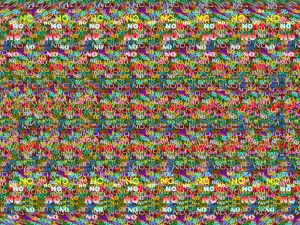 We’re talking a lot about character this month, as well we should. Great characters are critical components for great stories. We need to understand our characters, their relationships, and then we need to reveal the truth about our characters with a deft hand, weaving in back story and inner demons.
We’re talking a lot about character this month, as well we should. Great characters are critical components for great stories. We need to understand our characters, their relationships, and then we need to reveal the truth about our characters with a deft hand, weaving in back story and inner demons.
It can prove a daunting process, and sometimes it’s hard to know how to approach working with our characters to maximize their effectiveness. At times, it’s like looking at a hidden 3d image, like the one at the top of this article. Can you see the hidden image? It takes effort and practice to train your eye to see what’s right there.
Same with building great characters.
There are lots of opinions and articles and books on the subject, including this month’s Fictorians posts. One resource I highly recommend is Orson Scott Card’s book Characters & Viewpoint.
Another, which I found extremely helpful, is Larry Brooks’ Three Dimensions of Character. This is available as a standalone ebook, but is also incorporated in Larry’s best-selling book Story Engineering.
The brilliance of this approach is that it explains complex character building in a direct, understandable way that makes it accessible to every writer. Larry provides a toolbox to assist authors in crafting great characters, and knowing what is required to do so. He teaches, in essence, how to see the hidden image by removing some of the vague, mysterious elements from the process, which I found refreshing and extremely helpful.
I won’t explain the entire system. This short article won’t do it justice, but I will review the core concepts to illustrate the power of it.
Characters have three distinct dimensions that authors need to understand and define, and which they can then apply for greatest effect.
Dimension 1: Personality. What a character looks like, their quirks, how they present themselves to the world. This is all surface material, without any assigned meaning. For minor characters, this may be all we ever see, and it’s left to the reader to assign any deeper meaning, if they choose. For important characters, we cannot stop here without getting the dreaded “your characters are flat” reviews.
Dimension 2: Back story and inner demons. This is where things get interesting. This is the why of a character’s choices. This is where meaning is assigned, where they face their inner struggles, hide their deepest fears. It’s the world view that motivates their actions, and it may or may not coincide with the face they choose to show the world.
Dimension 2 is where characters gain depth, it’s where the reader gains a glimpse into the why, and gives us a chance to build empathy with the character, which is absolutely crucial for our story success.
However, we’re not finished with Dimension 2. Dimensions 1 and 2 are still what the character wants us to see, to understand.
Dimension 3 is where we get to the true heart of a character, their moral substance, or lack thereof.
Dimension 3 is what a character does in critical moments, moments of extreme stakes, moments that count. This is where everything is stripped away and their true, inner core is revealed.
It may surprise us. It may surprise them. This is where a character really becomes a hero, or a villain. It’s where they shine, or where they run away screaming. This is where inner demons are excised, when a character arc is complete. Only then is the hero ready to overcome the external antagonistic forces.
This is powerful stuff! Too often advice about character lacks this level of clarity. Larry goes on to expand upon this in his books, and I highly recommend you study his system, because it empowers authors to elevate character development to a much higher level.
To illustrate briefly: Assume we have a character, a middle-aged school teacher who works with first graders. Never married, but beloved by her children. All first dimension stuff. Then, let’s give the readers a glimpse into her past. Maybe she went into teaching because a younger sibling died and she always felt guilty for not protecting that child, and has dedicated her life to teaching to help excise that guilt. Second dimension back-story and inner demon. She’s an easy character to empathize with.
Then let’s set the school on fire. Children are in danger. What will she do?
Well, that’s the question, and the moment that will make the story. Will she rush into a burning room to save children, perhaps by making the ultimate sacrifice, and therefore justify her life’s work? Or will she break down and ignore everyone around her, perhaps letting children suffer because she’s unable to break out of the prison of her memories? Or does she do something totally different? It’s not until that moment of crisis that her true character is revealed.
In my next post, I’ll explore examples of great complex characters, and lessons we can learn from them.


